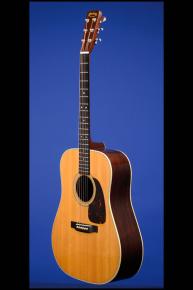A Near Mint 1959 Martin D-28
This near mint 15 1/2-inch/wide acoustic flat top weighs just 4.50 lbs. and has a fat nut width of just over 1 11/16 inches, a scale length of 25.40 inches and a body depth of just under five inches. Natural Solid Spruce top, Solid Brazilian Rosewood back and sides. The top of the body has six-ply black and white binding and the bottom of the body has three-ply black and white binding. The back has a checkered pattern backstrip. Mahogany "V" shaped neck with a medium-to-fat profile, ebony fretboard with 20 frets and pearl dot position markers. Headstock with gold decal "Martin & Co. / Est. 1833". Individual Grover Roto-Matic tuners with bell-shaped metal buttons. Tortoiseshell pickguard. Solid black ebony 'Belly' bridge with drop-in long saddle bridge string spacing. Serial number "170929" on wooden plate at end of neck. This guitar is in near mint (9.25) condition with just a few very slight surface scratches on the back, a few tiny indentations/surface scratches on the top and just a few very light 'fingernail' marks on the top between the sound-hole and the bridge. Together with the original 1959 Martin Catalogue. Housed in the original Martin five-latch dark gray hardshell case with cream piping and burgundy plush lining (9.25).
"From 1947 until the late 1960s, the Martin Dreadnought underwent only minor modernizations. The D-21 was added in 1955, and the D-35 ten years later." (Johnston & Boak. Martin Guitars. A Technical Reference. p. 94).
"Sometimes great ideas must wait for their time to come around and it was this situation for the D-28. In 1931 C.F. Martin introduced the D body shape guitars, the D-1 and the D-2. The D stands for Dreadnought, the largest British battleship. Extremely limited numbers of the D-1 and D-2 were made, so limited that these guitars must be the most collectable acoustics of all. When the guitar went into a proper production cycle it was slotted into the familiar Martin guitar numbering system - a letter of the alphabet to designate body size and shape followed by a number to indicate the style of finish and woods used. The D-18 was less ornate and had a mahogany back and sides paired with dark body bindings, while the D-28 used Brazilian rosewood for the back and sides and had herringbone trim and a zipper style back stripe. More expensive models - the D-35 and D-45 were produced but it was the D-28 that found its way into the hearts of guitarists from all spheres."
(http://guitar.suite101.com/article.cfm/the_most_famous_acoustic_guitar).
Translate:












